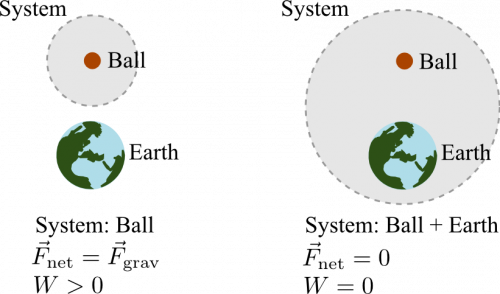This is an old revision of the document!
Choosing a System Matters
Earlier, you read about a puzzle involving a ball falling to the Earth. We resolved this puzzle by introducing the concept of potential energy. In these notes, you will revisit that example. The goal here is to demonstrate that the choice of a system matters.
A falling ball
Consider a ball initially at rest that begins to fall towards the Earth.
In the first case, you choose the ball to be the system. The kinetic energy of the ball increases because the work that is done by the gravitational force due to Earth (which is in the surroundings) does positive work on the ball. The displacement of the ball is down and so is the gravitational force.
For case 1 with the ball as the system,
- System: Ball; Surroundings: Earth
- Initial state: Ball at rest; Final state: Ball moving
- $\Delta K_{ball} > 0$ because $W_{surr} > 0$ ($\Delta K_{ball} = W_{surr}$
In the second case, you choose the ball and the Earth to be the system. The kinetic energy of the ball still increases, but now there's no external forces due to the surroundings and hence no external work because the Earth is included in the system.
For case 1 with the ball as the system,
- System: Ball + Earth; Surroundings: Nothing
- Initial state: Ball at rest; Final state: Ball moving
- $\Delta K_{ball} > 0$ but why? $W_{surr} = 0$
This puzzle will be resolved by considering energy associated with the interactions of particles within a multi-particle system. This potential energy is associated with how the different objects are configured with respect to each other and what their interactions are.
